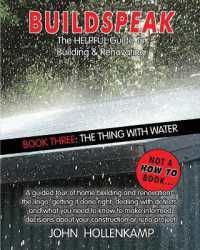- ホーム
- > 洋書
- > ドイツ書
- > Humanities, Arts & Music
- > Arts
- > architecture
Description
(Text)
Cities, estates and routing systems develop, change constantlyand fundamentally cannot be planned. Claims to ownership, landand building regulations, planning decisions and political interventionsmake it difficult for settlement structures to adapt to constantlychanging requirements to such an extent that meaningfuland totally ecological use of the surface of the earth is becomingincreasingly difficult, although new techniques and flexible planningmodels mean that a connection could be found with the self-designingprocesses of urban-development history.Plants are anchored in their location on the face of the earth, animalsand human beings have mobile territory and encampmentsthat become static with increasing density. Human settlements areorganisms, but they are not hereditarily anchored in their form likecorals, sponges or beehives. They often grow and shrink at thesame time. Their form can almost never be called chaotic. Typicalself-formation processes lead to astonishing genetic optimization inthe course of time. Processes of change have become so rapid todaythat current urban-planning theories have been overtaken.But high effectiveness of self-created, in other words unplannedsettlements in terms of energy and biology is totally achievable todayin »natural« town and transport planning and leads to ecologicallymeaningful solutions that are also full of beauty.The study was written in the context of special research into»natural constructions« by the Deutsche Forschungsgemeinschaft,and has hitherto been available only in German and as aworking paper for circulation between those involved in the researchproject.Frei Otto is one of the 20th-century's most important architecturalvisionaries. Although at a first glance his buildings like theGerman Pavilion for the 1967 World Fair in Montreal, designed withRolf Gutbrod, the roofs for the Olympic buildings in Munich designedby Günter Behnisch or the project developed with ChristophIngenhoven for a new main station in Stuttgart seem to be inthe tradition only of the great constructors of this century like FelixCandela or Pier Luigi Nervi, his work goes way beyond mere construction.He is a technician, artist and philosopher in one, and hiscentral concern is for a new and all-embracing link with nature inbuilding.
(Author portrait)
Frei Paul Otto, geboren 1925, war ein deutscher Architekt. Er entwarf das legendäre Dach des Münchner Olympiastadions. Posthum wurde er mit dem Pritzker Preis geehrt. Frei Otto verstarb im März 2015.








